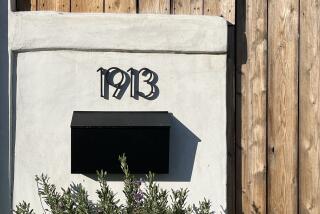Caution: Approaching Slippery Slope With School-Zone Signs
- Share via
They’ve changed the color of the school-zone signs in my neighborhood, and I am completely rattled. I realize I am taking my first trembling steps into codgerdom here--and in public, no less--but if we are to continue as a functioning society, a few things must be agreed upon, and one of those things is that school-zone signs are yellow.
Not the neon yellowy-green that is vibrating from the new signs in Glendale and other neighborhoods. Yellow. And not just any yellow. The warm, flat safety yellow that has been with us so long, an almost golden autumnal yellow that conveys its meaning without any explanatory figures or words. You see the shape, you see the color, and you know. A school. A school is present, so I should slow down. I should be cautious.
It is a Proustian madeleine of a color, calling to the mind’s eye school buses and crayon boxes, children’s rain slickers and old-fashioned galoshes, the kind with the buckles. It is not a color you could wear unless you were prepared to stencil “Caution: Children” across your backside. Neither do you see many houses painted this yellow. It is the color of lunch pails and the occasional fire hydrant. It shows up on other safety signs--alerting motorists of railroad tracks and, in southern Southern California, of families fleeing across the border. It is the color of caution--as close as paint can get to the amber light in a traffic signal. It may not be the most vibrant shade around, but it is part of our internal, as well as external, landscape. It has been wired into our consciousness. That little yellow button.
Undoubtedly, this new Day-Glo hue, a sort of tennis-ball yellow, is more eye-catching; the signs seem to fairly dance beside the road, like the poster board people use to advertise really big garage sales. Those objects in the background--particularly the schools--tend to look drab, worn down, outdated in the glare of the sign’s corona, which can’t be good for taxpayer moral. But more important, this nouveau yellow doesn’t speak of safety at all. More reminiscent of a black-light poster than a school bus, it lends a vaguely stoned atmosphere, a sort of visual Hendrix riff, to the scene, which seems inappropriate, if not absolutely counterproductive.
I know, I know, it’s just a sign. But still. Remember when all the lemon-lime firetrucks started showing up? Remember how weird and unsettling that was? As if somewhere someone had decided to just mess with our minds. Just to see what would happen. For a while, there were rumors that the red firetrucks would soon be completely replaced. That hasn’t happened, of course, and you want to know why? Because firetrucks are supposed to be red.
What do we teach our children, before the alphabet, before the numbers, before the shapes. We teach them colors. The sky is blue, the leaves are green, the apple is red. Color anchors us to the world. It is one of a relatively few aspects of living upon which most of humanity agrees. It is not something to be tinkered with lightly.
Imagine if one day all those orange pylons turned purple. Or turquoise. Imagine if the LAPD decided to make its black-and-whites pink and green. Distinctive. Easy to spot. Absolutely unacceptable.
There is great power in the use of color, perhaps more even than in the use of words--just take a look at the laundry-detergent aisle in any supermarket. More than print ads, more than radio, more than even television, the right color combos sell soap.
And safety. Red means stop, green means go--and that predictable, instantly recognizable yellow means slow down.
Or at least it did in my day.
*
Mary McNamara can be reached at mary.mcnamara@latimes.com.



